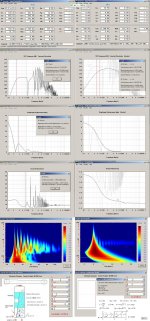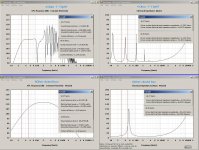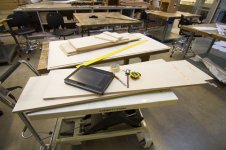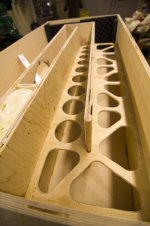Kepp in mind that both manufacturers use different xmax-values in the spec sheet. Eminence measures with a klippel, BMS states the geometrical value. So the "measured" xmax on the BMS is much higher (or the geometrical xmax of the LAB is much lower, works eather way)Poseydon - It would work (see pic) but not nearly as well. X-max is only 8 mm for the BMS, while the LAB 12 is 12 mm.
Thanks a lot guys!
It is obvious that the simulation with the BMS is not as good as the LAB12 and probably I am going to give up the idea. I was looking for a multi-purpose solution speaking of subwoofers /usable frequency 20-150hz/ but unfortunately there is none.
Here is what i would like to accomplish:
1. Front Stereo Channels should be a combination of fast, dynamic and detailed bass response. Probably a good idea is to build 2 subs like MTH-30 or something like it. Lower usable frequency >= 45hz.
2. Subwoofer channel speaker should go deep down to 20-25hz. Probably only one sub.
So the separation should look like this way:
20-40/45hz - subwoofer channel
45-150 - front stereo channels.
Speakers available here in Bulgaria:
Most of the BMS speakers
All Visaton Speakers
Some of the Eminence Speakers
Thanks a lot.
Greetings!
It is obvious that the simulation with the BMS is not as good as the LAB12 and probably I am going to give up the idea. I was looking for a multi-purpose solution speaking of subwoofers /usable frequency 20-150hz/ but unfortunately there is none.
Here is what i would like to accomplish:
1. Front Stereo Channels should be a combination of fast, dynamic and detailed bass response. Probably a good idea is to build 2 subs like MTH-30 or something like it. Lower usable frequency >= 45hz.
2. Subwoofer channel speaker should go deep down to 20-25hz. Probably only one sub.
So the separation should look like this way:
20-40/45hz - subwoofer channel
45-150 - front stereo channels.
Speakers available here in Bulgaria:
Most of the BMS speakers
All Visaton Speakers
Some of the Eminence Speakers
Thanks a lot.
Greetings!
A very large corner loaded horn could give you three octaves.I am going to give up the idea. I was looking for a multi-purpose solution speaking of subwoofers /usable frequency 20-150hz/ but unfortunately there is none.
A tapped horn that is considerably smaller is unlikely to get more than two octaves.
Two or three 18inch drivers could get to three octaves, but either box volume gets very big or power goes through the roof.
AndrewT, I understand your idea but unfortunately the room is not big enough.
I have two free corners in which I can place 250*40*40 cm box.
If I use a single folded design /tapped horn?/ with 12" speaker probably I will get down to 25hz?
Probably my questions is not placed in the correct thread...Sorry for that!
I have two free corners in which I can place 250*40*40 cm box.
If I use a single folded design /tapped horn?/ with 12" speaker probably I will get down to 25hz?
Probably my questions is not placed in the correct thread...Sorry for that!
Hi,
if the 12inch is the eminence driver and you build a tapped horn then you are in the correct thread.
If you set your TH to achieve 25Hz then expect ~100Hz as a reasonable maximum frequency.
if the 12inch is the eminence driver and you build a tapped horn then you are in the correct thread.
If you set your TH to achieve 25Hz then expect ~100Hz as a reasonable maximum frequency.
...I was looking for a multi-purpose solution speaking of subwoofers /usable frequency 20-150hz/ but unfortunately there is none...Here is what i would like to accomplish:
1. Front Stereo Channels should be a combination of fast, dynamic and detailed bass response. Probably a good idea is to build 2 subs like MTH-30 or something like it. Lower usable frequency >= 45hz.
2. Subwoofer channel speaker should go deep down to 20-25hz. Probably only one sub...So the separation should look like this way:..20-40/45hz - subwoofer channel...45-150 - front stereo channels...Speakers available here in Bulgaria:..Most of the BMS speakers..!
Hi, If you consider the MTH-30 using the BMS-12S330, you're leaving, IMO, Hi-Fi SQ for live PA Mid sound colorations/artifacts. See a simulated example using this driver in a system capable of THX levels and superior SQ:
b🙂
Attachments
Hi B,
I'm confused.
Which column of reports belong to which arrangement?
I see Tapped Horn and T-TQWT and sealed box.
I'm confused.
Which column of reports belong to which arrangement?
I see Tapped Horn and T-TQWT and sealed box.
Last edited:
Hi B,
which column of reports belong to which arrangement?
I see Tapped Horn and T-TQWT and sealed box
Hi Andrew,
The first vertical column concerns a T-TQWT-sub and the second to a closed mid-bass box: suggested to be a part of a main speaker system.
b🙂
Then,
why does the TQ show 290W (effic~0.3%) for 30.98V input,
but the sealed shows 9W (effic~2%) for 30.98V input?
why does the TQ show 290W (effic~0.3%) for 30.98V input,
but the sealed shows 9W (effic~2%) for 30.98V input?
Then,
why does the TQ show 290W (effic~0.3%) for 30.98V input,
but the sealed shows 9W (effic~2%) for 30.98V input?
The efficiency depends on the different specific system load impedance given as a function of the frequency in use : See the picture for more comparisons.
b 🙂
Attachments
I think I have it.
The reported power input relates to the input voltage and the speaker electrical impedance at that frequency.
When the frequency hits a peak in the electrical impedance, Hornresp reports a high efficiency and when frequency does not coincide with a peak then Hornresp reports a lower efficiency.
Is that correct?
The reported power input relates to the input voltage and the speaker electrical impedance at that frequency.
When the frequency hits a peak in the electrical impedance, Hornresp reports a high efficiency and when frequency does not coincide with a peak then Hornresp reports a lower efficiency.
Is that correct?
Bjorno,
How does the mouth of a T-TQWT compare to the port of a vented box with regards to port compression/chuffing?
How does the mouth of a T-TQWT compare to the port of a vented box with regards to port compression/chuffing?
I am building one of these and I was wondering a few things. I plan on making the outside baltic birch and I was wondering if it would be okay to use 3/4" subfloor ply for the inner baffles. I was also wondering if the dampeing material had been sorted out. I have some 1" egg crate style acoustic absorbing foam, would that be useable? And that last thing, what is everyone using as a highpass?
Hi all,
Maybe too delayed answers but there is a reason why I haven't posted in time :Computer problems..
Andrew T: post#111
b: Yes
fb😛ost# 112
b : If the terminating port is large enough, i.e. Port is >= Sd/3 : No chuffing is expected.
lightlinked: post# 113
b:
Hi,
Which Driver/Plan are you following ?
b🙂
Maybe too delayed answers but there is a reason why I haven't posted in time :Computer problems..
Andrew T: post#111
When the frequency hits a peak in the electrical impedance, Hornresp reports a high efficiency and when frequency does not coincide with a peak then Hornresp reports a lower efficiency.
Is that correct?
b: Yes
fb😛ost# 112
How does the mouth of a T-TQWT compare to the port of a vented box with regards to port compression/chuffing?
b : If the terminating port is large enough, i.e. Port is >= Sd/3 : No chuffing is expected.
lightlinked: post# 113
I am building one of these and I was wondering a few things. I plan on making the outside baltic birch and I was wondering if it would be okay to use 3/4" subfloor ply for the inner baffles. I was also wondering if the dampeing material had been sorted out. I have some 1" egg crate style acoustic absorbing foam, would that be useable? And that last thing, what is everyone using as a highpass?
b:
Hi,
Which Driver/Plan are you following ?
b🙂
I'm using the lab12 and the 5.5 meter design by Don Snyder. So far I have the outside pieces cut, I also have the driver and all the wood, so this might be glued up by Friday. I was also thinking of using 1/2" subfloor for bracing.
i'm about to build this i have the perfect amount of space under my TV for it and i have the lab 12. just figuring out a cut sheet since i didn't see one posted here. i'll post up pics in the process!
It took me two sheets of 5' x 5' x 3/4" baltic birch, 26" x 48" x 3/4" of underlay ply for the inner baffles and a chunk of 1/2" subfloor ply for bracing. If you use biscuits, the inside ones have to be layed out perfect or the side will not go on easily.
Attachments
damn that bracing looks crazy! i didn't use any bracing on mine, i just used 3/4" mdf for the whole project.
i banged it out a lot faster than i expected...i figured i'd just go buy the wood today and get started on it..but here it is! just gotta sand and paint, and make an access panel cover!
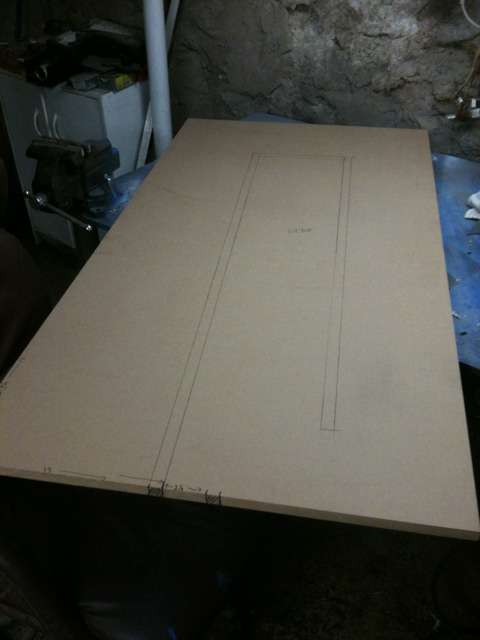
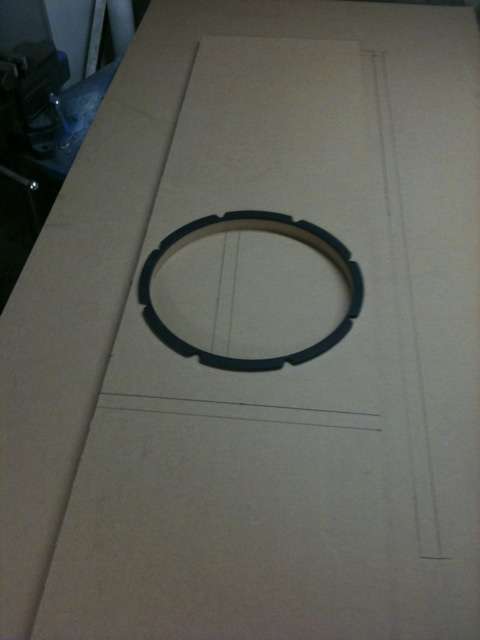
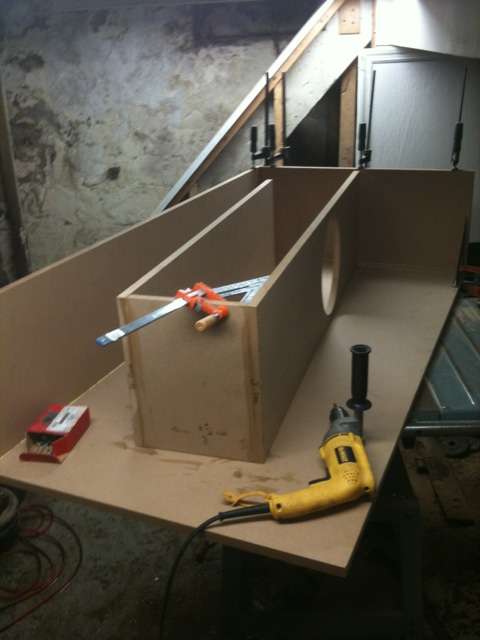
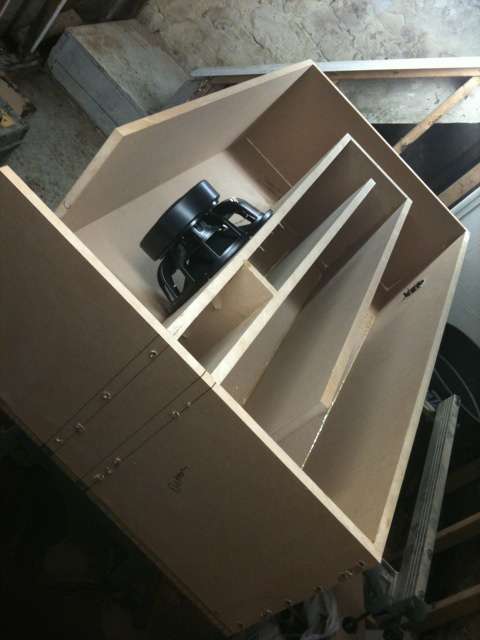
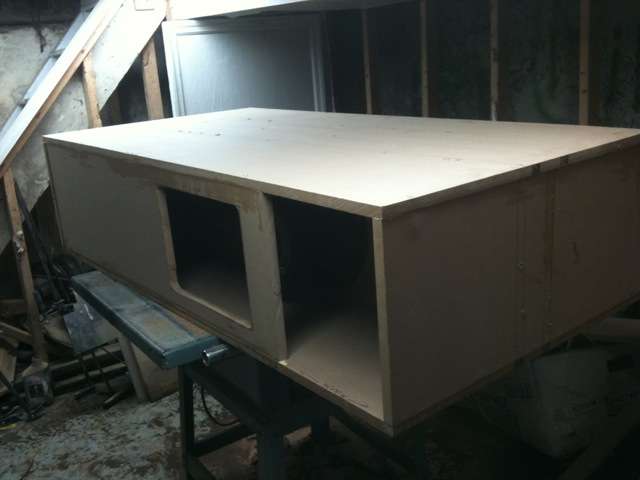
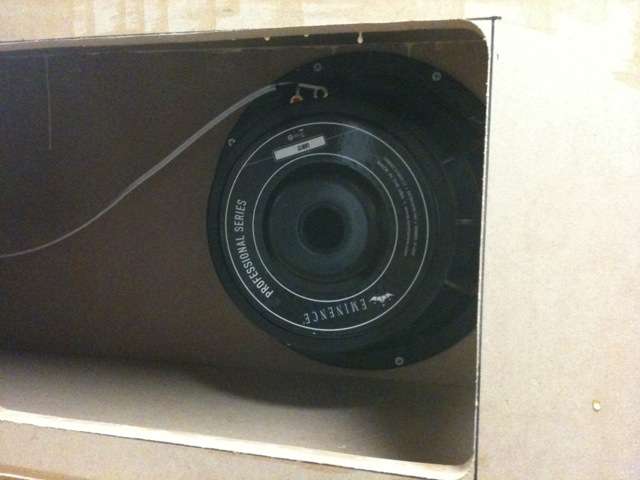






- Home
- Loudspeakers
- Subwoofers
- Lab12 - Tapped Horn
